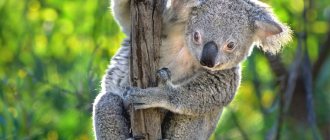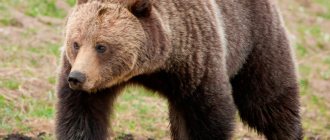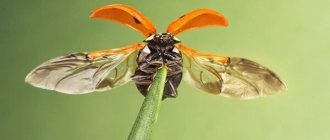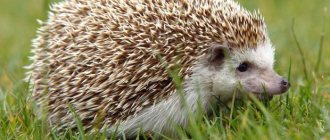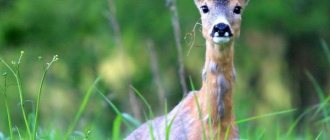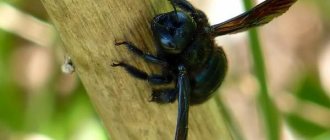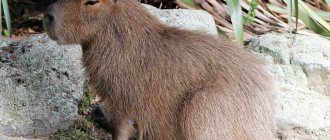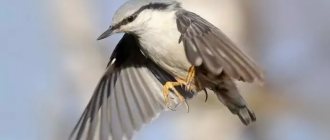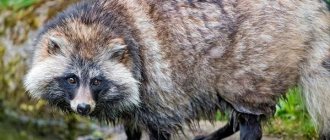- Difference from a pig
The wild boar is the direct ancestor and close relative of the well-known domestic pig, an animal domesticated by man back in the distant Stone Age. It is believed that the wild boar, which was the least afraid of people among animals and often came to “visit”, was tamed second after the dog. And over the centuries, it has become so deeply integrated into human culture, albeit under the guise of a pig, that it even became one of the symbols of the year according to the Chinese horoscope. And by the way, our site sincerely congratulates all readers on the upcoming 2022 year of the pig or wild boar, which is what our article is about today.
Description
Wild boar in its natural habitat
Before the Ice Age, there were several families of artiodactyls with certain characteristics. But only one has survived to this day, to which scientists gave the name “real pigs.”
Now this family is divided into five genera:
- the babirusa lives on the island of Celebes;
- Warthogs are common in Africa;
- the long-haired pig has adapted to the tropical climate;
- Wild boars live in Europe, Asia and Africa.
The latter genus lives in many places on Earth and is divided into three main species:
- the common wild boar, found in most countries;
- in the Himalaya mountain range there is a pygmy pig;
- The bearded pig is common on the Celebes Islands, the Philippines, Java and Sumatra.
It is these three species that now represent wild boars on Earth, and they are also divided into different subspecies, depending on their habitat. Their appearance may differ, but their habits and lifestyle are largely the same.
Appearance and features
Body structure of a wild boar
A wild boar is visually similar to a pig, but due to harsher living conditions it has characteristic differences. Adults have a massive body covered with hair. Beneath it are hidden strong and durable muscles that can withstand high loads.
The body is round in shape, supported on short legs. At the back there is a small tail covered with sparse hair. Due to the narrow pelvis and wide sternum, the boar looks like a barrel.
The head is connected to the body by a wide neck.
The head is elongated, with high-set eyes. The nose is located above the mouth in the form of a dark spot. At the level of the forehead, at the edges, there are ears sticking up. Long fangs grow at the edges of the mouth, which are the main distinguishing feature of wild boars from other pigs. They help tear up soil and foliage to search for food, and are also used for defense and attack. Interesting fact : adult boars' tusks can grow up to 25 cm in length.
Their average length is 15-17 cm. The hair of wild boars is hard and unpleasant to the touch. The color depends on the place of residence of the individual. Color varies from gray to dark brown. Those species that live in cool areas acquire thicker fur with the onset of winter, which allows them to survive in the snow.
The animal grows up to a meter in height and up to two meters in length. Due to their massive body, wild boars have a large mass, which in adult individuals averages 150-200 kg, but especially developed ones can weigh up to 300 kg. Males grow much larger than females.
For Russia, wild boars are not uncommon. The country is home to five subspecies with unique appearance features:
- Central European wild boars are small in size and have dark skin;
- The Ussuri has large dimensions, but the main distinguishing features are small ears and white fluff under the nose, reminiscent of a mustache;
- the Caucasian has light fur and a large head;
- Transbaikal - a small animal with a brown color;
- The Central Asian has light hair on the body and dark hair on the legs.
Despite the visual differences between the species, it is always easy to see that they belong to the wild boar family.
Interesting facts about the animal
- In captivity, animals exist less than in nature. The average life expectancy is 14 years.
- Females reach sexual maturity at 1.5 years.
- According to Miller's dream book, a boar in night dreams is a sign of great luck.
- It is important for hunters to know how to distinguish a female from a male, because killing a sow can result in a serious fine.
- Boars have an excellent sense of smell, but their eyesight is poor. An animal may not see a person from a distance of 15 meters.
- In ancient times, hunting these artiodactyls was a test for young men. Only by killing a boar did a guy become a man.
- The bristles of the beast are used to produce toothbrushes, combs and paint brushes.
Where does the wild boar live?
Wild boar habitat
Boars adapt well to any weather conditions. Some subspecies feel comfortable in tropical climates, while others prefer cool weather. Many wild boars choose forested areas, and they can live well in oak, coniferous and other groves. Some individuals live in mountain ranges and near swamps.
Wild boars can be found in North Africa, Asia, and Eurasia. Their range extends from the Ural Mountains to the Atlantic Ocean. Also, some species willingly inhabit different islands.
In the past, the habitat of this animal was many times larger. But with the advent of man on the planet, it decreased significantly. For example, in England the animal was completely exterminated by local hunters, and now not a single individual lives there.
Interesting fact : people brought wild boars to North America for the purpose of conducting one-time hunts, but the animal took root well and is still increasing its population in these lands.
In any of the territories, regardless of environmental conditions, the wild boar takes root well and feels at home. This once again emphasizes the versatility of the beast in terms of adaptation and survival.
Interesting: Wolverine

